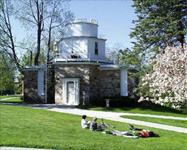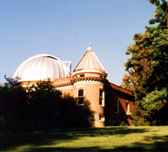|
|
Q 'n A
Answers To Your Questions
SPACE TODAY ONLINE ~~ COVERING SPACE FROM EARTH TO THE EDGE OF THE UNIVERSE
Q. What's the oldest astronomy observatory in America? — Russell L.

Hopkins Observatory |

Cincinnati Observatory |
A. Well, could it be the Hopkins Observatory at Williams College in Massachusetts or is it the Cincinnati Observatory Center in Ohio?
It's Hopkins Observatory, according to Jay Pasachoff, director of the observatory.
"The Hopkins Observatory, built at Williams College in 1836-1838, is the oldest astronomical observatory extant in the United States," he says.
"Founded by Professor Albert Hopkins and built together with his students, it still contains the oldest known Alvan Clark telescope. Some of its historic instruments are mounted in its wings, known as the Mehlin Museum of Astronomy, and its central internal domed-ceiling room is the Milham Planetarium," Pasachoff writes in an abstract of his article Williams College's Hopkins Observatory: the oldest extant observatory in the United States in the Journal of Astronomical History and Heritage. [Vol. 1 No. 1, June 1998, published at James Cook University in Australia]
"The building is still standing; it now houses a second-generation telescope, Alvan Clark's first, installed in 1851, and a new Zeiss planetarium as well as exhibits. So we have the oldest extant astronomical observatory in the United States," Pasachoff explains.
Williams College professor Albert Hopkins went to England in 1834 to search for astronomical apparatus. Back in the U.S. with equipment for a new facility, Hopkins and some of his students constructed the observatory by hand from 1836 to 1838. That building is now the Williams College planetarium. It was moved around campus in 1908 and in 1961.
Some of the original equipment from the 1834 trip to England survives including a transit, a regulator, and a rule.
Meridian. The meridian is an imaginary great circle on the surface of the earth passing through the north and south poles at right angles to the equator.
Transit. Transits are astronomical telescopes used to measure when a star transits or crosses the meridian.
Regulator. A regulator is an accurate pendulum timekeeper that looks something like a grandfather clock.
Refractor. A refracting telescope uses a lens to bring light to a focus at the end of a long tube.
The Troughton & Simms meridian transit now is displayed on a wall in the west wing of the Hopkins Observatory. That original transit was replaced in 1876 by a larger transit in the east wing. The larger transit was used to compile a book of positions of stars called The Williams College Catalogue of North Polar Stars in 1888.
The transit was used with another part of the original equipment from England, the Molyneux and Cope regulator. The Hopkins Observatory regulator has a mercury-compensated pendulum. A jar of mercury at the bottom of the pendulum expanded and contracted, which compensated for changes in the length of the pendulum due to temperature.
The firm of Alvan Clark at Cambridge, Massachusetts, in 1852 built a 7-inch refracting telescope, which replaced an earlier telescope. It was restored for the Observatory's sesquicentennial.
Today, the main telescope of the Hopkins Observatory is a 24-inch reflector on the roof of the physics and astronomy building.
The domed ceiling of the planetarium was black with stars painted on it until 1963 when a planetarium projector was installed.
Cincinnati. In contention for the title of "oldest" is Cincinnati Observatory Center in Ohio.
In fact, the Cincinnati Observatory has been called the birthplace of American astronomy. The Observatory calls itself home to the nation's "oldest professional telescope still on view" for the public. It has been designated a National Historic Landmark.
The Cincinnati Observatory Center was founded in 1843 when the cornerstone of the original building was laid by President John Quincy Adams in a section of town that became known as Mount Adams. It's not on that hill now, but it's still in Cincinnati. The observatory moved to Mount Lookout in 1873.
"Williams College's Hopkins Observatory was built...a half dozen years before Cincinnati's," Pasachoff points out.
"Cincinnati may have the oldest general-purpose telescope that is on display – though, actually, we have our original meridian transit, purchased in England in 1834, from Troughton and Sims, a noted maker, on display, and that is a special-purpose telescope, but a telescope nonetheless," he says.
The University of Cincinnati turned the Cincinnati Observatory Center over to to a group of neighbors and supporters who operate it now.
The observatory's main building was constructed in 1873 and the O.M. Mitchel Building was built in 1904. A renovation started in 1999 restored the dome in the main building, the library, the wooden floors and the clock that operates the telescope. Workers cleaned brickwork and repaired the roof, walls and windows.
An astronomy museum in the main building includes items from Chicago's Adler Planetarium and other museums. The hilltop grounds offer a sitting garden.
They say 6,500 people, including many a grade schooler, stop by each year to peer at and through the Observatory's equipment.
Learn more:
Hopkins Observatory at Williams College:
Cincinnati Observatory Center:
 Ask Space Today Online another question Ask Space Today Online another question
 Return to the Questions 'n Answers main page Return to the Questions 'n Answers main page
|


 Ask Space Today Online another question
Ask Space Today Online another question